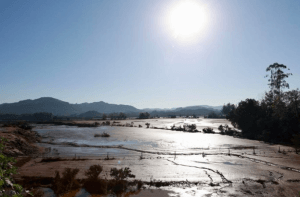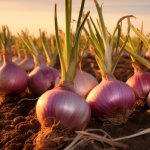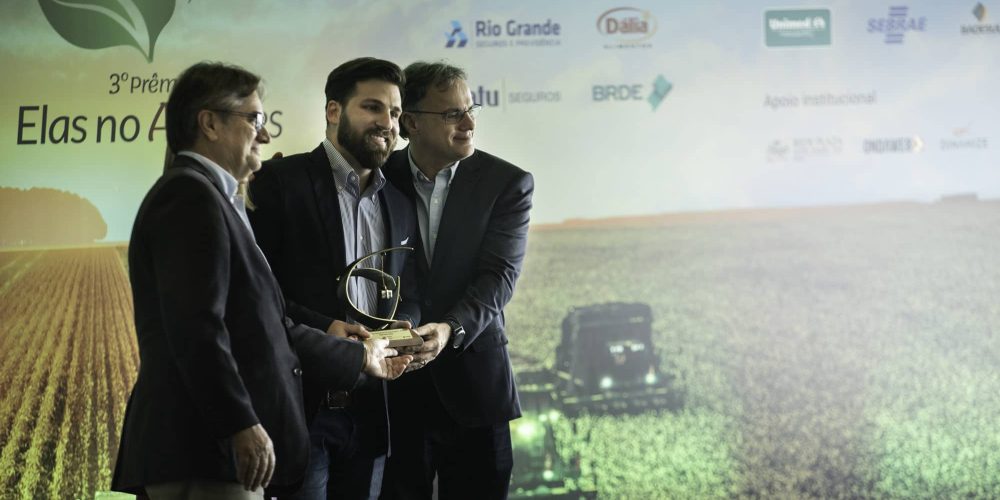The high volume of rain that the state of Rio Grande do Sul received in a short period of time, combined with a naturally rainy year, caused several damages to the soil structure, physically, chemically and biologically speaking. As this is a recent topic, several news portals are discussing the subject, and experts and professors in the area have explained how soil recovery can be resumed in these affected regions.
In the steepest areas, the water literally ran downhill, taking with it not only the production, but also a significant part of the soil (Figure 1). The main layer that was lost, the surface layer, is the one with the greatest accumulation of organic matter, and therefore the most fertile part of these lands (Zero Hora).

Figure 1. Flood water left entire crops submerged and a trail of destruction on rural properties. Jefferson Botega / Agencia RBS.
A study carried out by researchers from the Faculty of Agronomy at the Federal University of Rio Grande do Sul (UFRGS) and members of the Soil and Water Conservation Association estimates that the loss, in soil and nutrients alone, is R$1.4 billion (Zero Hora).
According to a technical note from MapBiomas, the flood affected almost 1.6 million hectares in the state of Rio Grande do Sul. Of this total, 64% correspond to rural areas, of which the majority (40%) is dedicated to agriculture and another significant portion is used for various agricultural purposes, identified as a mosaic of use (25%) (Zero Hora).
Amanda Posselt Martins, a professor in the Department of Soils at the UFRGS School of Agronomy, explains that soil fertility is built up over years of management. And many of the affected areas are areas that have been historically used, such as the Vales region. In these areas, the loss of the fertile layer is like the loss of the home of these crops — the organic matter in the soil is the home of many organisms. Just as people's homes were taken away, the habitat of a variety of organisms was also gone. So, it is a reconstruction from scratch on several levels.
— It was extremely disastrous for the soil. Either it carried a layer to the rivers and was lost, or it deposited considerable layers on other soils. This causes a very big disturbance. Of course we must consider the different regions, but it was a very damaging effect and the recovery will be very expensive — anticipates Pedro Selbach, professor at UFRGS and one of those responsible for the study that outlines the financial damages (Zero Hora).
Sustainability Manager at SIA Brasil, Agribusiness Intelligence Service, Gustavo Heissler, points out that each area has its own characteristics of relief and formation, and this has different impacts on losses. Furthermore, the damage was not only to nutrients, requiring actions that go beyond soil correction (Zero Hour).
Soil compaction is directly associated with the water infiltration capacity. The problems resulting from it are present in both extreme events that have affected RS in recent years: in droughts, when the soil does not store water, and in floods, when shallow soil allows water to run off (Zero Hour).
The first step, according to SIA manager Gustavo Heissler, is to analyze the soil to understand the chemical, physical and biological conditions of the land. This diagnosis will help in making decisions about how to start the recovery and which techniques to use (Zero Hora).
Direct planting is one of the practices that helps with recovery, creating favorable conditions for the reestablishment of microorganisms, the cycling of nutrients that are still in the soil and the creation of a protective layer. Soil coverage itself is a fundamental technique in its own right, as is crop rotation (Zero Hour).
Heissler also suggests the application of precision agriculture techniques, which allow identifying areas of fertility and treating each point individually, making the land uniform (Zero Hour).
In the case of pastures, which were also damaged by the flood, recovery tends to be faster. Although their losses will have long-lasting effects on the supply of milk and meat (since pastures are part of the animals' diet), the tendency is for the areas for this purpose to be ready before the planting areas (Zero Hour).
Considering watersheds and promoting reforestation also serve to mitigate the effects of climate catastrophes, adds Amanda Posselt Martins — Trees play a fundamental role in this. In years of drought, to seek water with their roots and redistribute water, and in floods, to restructure the soil and make it more resistant to the erosion process — she says. (Zero Hora).
According to the professor of the Department of Soils, at the School of Agronomy of the Federal University of Rio Grande do Sul (UFRGS), “We know that fertile soil is something that is built over years of hard work and good management, especially in our subtropical climate, where the fertility of a soil is directly related to the organic matter content. Or, in other words, related to the life of the soil. Just as the water took the homes of many people, it also took the homes of countless organisms responsible for promoting the fertility of our soils, which are the basis of agricultural production in Rio Grande do Sul. Now, we have a new beginning to make for the fertility of our soils,” she notes. (Agrolink).
Amanda, together with a group of professors from the UFRGS School of Agronomy, proposes a new perspective on agriculture and livestock farming, with the implementation of management practices that are capable of regenerating soil fertility in a shorter period of time, such as integrated production systems and agroforestry systems, always based on conservationist soil management practices. “These two systems, integrated systems and agroforestry systems, have been studied for a long time by several studies conducted here at UFRGS and are characterized precisely by promoting greater biodiversity in the production system, both above and below the soil surface. This is the result of many years of research, which proves that such practices result in high primary productivity, that is, greater productivity of the agricultural product that generates economic return, which is of direct interest to the rural producer, and also something that is of interest to society as a whole, which is a much greater provision of soil functions, mitigating the severity of extreme weather events”, she emphasizes. (Agrolink).
Rural producer Murilo Teixeira Gonçalves from São Gabriel (RS) emphasizes that soil is the basis of any system and that there are three pillars for this: the chemical pillar, the physical pillar and the biological pillar. “We need a balance between them to maintain the soil’s own microorganisms. What happened with this excess rain, especially during harvest time? Many of our soils were uncovered or without a cover crop, and we know that the kinetic energy of the raindrop directly hits the soil, splashing and carrying away small aggregates that end up sealing the surface pores, through which water should infiltrate. Therefore, we had a lot of erosion losses, with the soil being displaced by water due to the lack of a macropore structure, responsible for the rate of water infiltration into the soil, or due to the lack of cover,” he emphasizes. (Agrolink).
Gonçalves also recalls that in some areas of his property, he had already planted crops in which he observed that the entire root system was able to maintain the aggregates and the organic part, which is the most special and richest part of the soil, preventing its loss. “I think this highlights the importance of always having some plant occupying the soil, without leaving it exposed to the sun. This also prevents raindrops from hitting the soil directly, breaking down their energy in the mass of the plant leaves that cover it. I believe this leads us to reflect on the need for proper direct planting. We still have some people who, in areas where it is not necessary, perform mechanical soil management, which is very harmful. We have seen many crops losing large amounts of soil due to this mechanical management. Therefore, we must seek to have this diversity of plants, keeping the soil covered for as long as possible, to obtain a better infiltration rate and less loss through erosion”, he concludes. (Agrolink).
In an interview, Sanear Ambiental expert Rafael de Souza Timbola talks about satellite images that show a large area of soil degradation in the state. Timbola says that the first step towards recovery involves restoring riparian forests. These areas of vegetation along rivers are critical for preventing erosion during possible flooding events. (Planeta Campo).
Furthermore, it is crucial that farmers decompact the soil and perform analyses to understand the extent of the damage and the need for nutritional correction. Tímbola also suggested planting forage crops such as forage peanuts, jack beans, Gandu beans, millet and forage sorghum, which help to fix nutrients and protect the soil against future erosion. These practices are essential to gradually restore soil productivity (Planeta Campo).
After reading this information throughout the text, how can ILSA help in this soil reconstruction?
ILSA products contain an assimilable organic matrix rich in organic nitrogen, carbon and amino acids known as AZOGEL®. With its high content of organic substances and low C/N ratio (<4), AZOGEL® stimulates microbial activity in the soil, thus helping to recover the richest layer of the soil. When added to the system together with mineral nutrients (organomineral fertilizers), these products also return the most important elements to accelerate production and recycling. It is important to remember the importance of carrying out soil analyses in order to choose the most suitable product for each type of situation.
References:
Agrolink: Crop soils will need to be restored after floods in Rio Grande do Sul
https://www.agrolink.com.br/noticias/solos-de-lavouras-precisarao-de-recuperacao-apos-enchentes-no-rio-grande-do-sul_491565.html, accessed on 03/07/2024.
Planet Field. https://www.youtube.com/watch?v=yjb11uMIJQo accessed on 03/07/2024.
Zero Hour. Flooding took away fertile soil layer, and recovery will require productive adaptation https://gauchazh.clicrbs.com.br/economia/campo-e-lavoura/noticia/2024/06/enchente-levou-camada-fertil-dos-solos-e-recuperacao-vai-exigir-adaptacao-produtiva-clx3lifb601cv015da8s1lwer.html, accessed on 03/07/2024.
Authors
Agr Eng. Dr. Angélica Schmitz Heinzen
Agricultural Eng. Msc. Thiago Stella de Freitas






